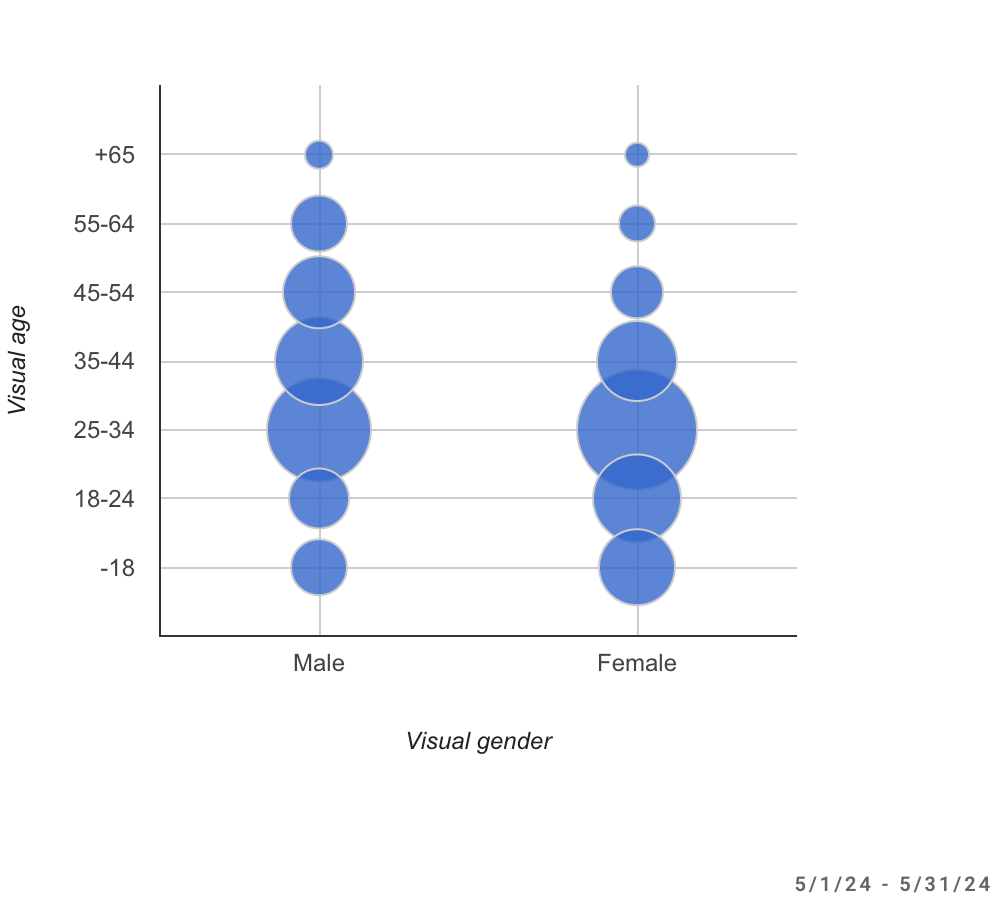
May 2024
What was measured
We analyzed the top 1000 Belgian TV, Online, and Print advertisements from May 2024 ranked by media investment. We extracted 1217 faces of talent from these ads and mapped the representation of age, gender, and ethnicity using an image analysis algorithm and human quality control. "Talents" refer to actors, models, and depicted persons in advertisements.
| Channel | Number of assets | Number of talents |
|---|---|---|
| Television | 652 | 1007 |
| Online Ads | 59 | 87 |
| 289 | 183 | |
| Total | 1000 | 1217 |
Remark: Some talents will appear in ads on multiple channels, therefore the total of all channels is not the sum. The total of all channels is the number unique talents across all channels.
Age representation
In this chart we see the visual age distribution of talents featured in the Top 1000 ads, compared to the age of the Belgian population (green area),
The visual age distribution is centered around age group 25-34, good for 35% of talent. This is more outspoken than in other months. The next two age groups are 35-44 and 18-24 , good for 19% and 16% of all talent respectively. Age group is -18 and 45-54 account for 12% and 11% of talent respectively.
Talents looking 45 and above account for only 19% of talents, while they represent 46% of the population and 53,5% of buying power.
Age distribution of casting in Top 1000 Ads compared to Belgian Population
Age by media
Online ads feature the youngest talent with over 40% of talent visually aged 24-34. As in previous months, Print Ads shift towards older talent with all ages above 45 being represented more than in other channels. Talent looking older than 45 account for 32% in Print ads and 22% on Online ads.
Online
Television
Gender representation
Gender isn't simply a binary attribute determined by visual appearance. Our model, however, uses facial features to determine whether a person looks male or female.
Across the Top 1000 ads, we find 47% male talents and 53% female talents. This is slightly less female representation than in most previous months.
Visual Gender distribution of talent in Top 1000 Ads
Gender by media
In previous months TV Ads and particularly Online Ads would portray more female talent than Print Ads. This month we see a surprising low 43% female representation in Online ads, and in line with previous months 54% female representation in TV ads and 48% in Print ads.
Online
Television
Gender x Age
Female talents are younger than male talents when we cross visual age and visual gender. Under the age of 35 we see more female talent, over the age of 45 we see less female talent in the Ads. We observe this trend month after month.
| Age | Male | Female | Difference F-M/F+M |
|---|---|---|---|
| 65+ | 1% | 1% | 0% |
| 55-64 | 4% | 2% | -33% |
| 45-54 | 7% | 4% | -27% |
| 35-44 | 11% | 9% | -10% |
| 25-34 | 15% | 20% | 14% |
| 18-24 | 5% | 10% | 33% |
| -18 | 4% | 8% | 33% |
Visual Gender crossed with visual age of talent in Top 1000 Ads
Ethnic representation
According to the analysis, 83% of talents are perceived as White (56% White + 27% Mediterranean White/Middle Eastern) compared to 17% non-White. Black talent makes up 10% of depicted persons, while Asian talent makes up 4%. This is in line with previous months.
Based on facial features, the data model predicts the likelihood that a talent belongs to one of the ethnic/race groups. Due to the fact that there are no hard boundaries between ethnic/race groups, a talent can be perceived as having a dominant and a secondary ethnicity/race.
In addition to White (lighter) and Mediterranean White/Middle Eastern (darker), the model detects Black, Asian, South Asian (e.g. India, Pakistan) and Latine/Hispanic looking people.
Visual Ethnicity distribution of talent in Top 1000 Ads
Ethnicity by media
Overall, TV ads display the most ethnic diversity, while print ads show the least. Surprisingly, this month, ethnic diversity is also limited in online ads, which had previously been the most diverse channel.
Online
Television
Representation of Disability
Along with demographic representation, our image analysis algorithm detects visually detectable disabilities, including wheelchairs, mobility aids, canes, and prosthetic limbs.
We detected two brands that portrayed people with disabilities. Orange and Rexona. Orange shows video ads featuring a Paralympic wheelchair athlete. Rexona features a person with a prosthetic limb without making disability the central focus. This approach helps normalise disabilities.
Comparing sectors
Age representation per sector
The Media and Publishing, Food and Drinks, and Distribution and Retail sectors (mainly supermarkets and online retailers) exhibit the most age diversity, meaning they represent a wide range of age groups. As shown in the Media and Publishing chart below, the representation of all age groups—except those under 18 and over 65—is aligned with the general population.
As in previous months, the Beauty and Hygiene sector seems to stick to the notion that young is beautiful and aspirational for older audiences. Also Tourism and Culture and Cleaning Products exhibit little age diversity.
Sectors showing the most age diversity in their ads
| Rank | Sector | Diversity score | % 45+ |
|---|---|---|---|
| 1. | media and publishing | 77 | 32% |
| 2. | food and drinks | 71 | 20% |
| 3. | distribution and retail | 70 | 12% |
Sectors showing the least age diversity in their ads
| Rank | Sector | Diversity score | % 45+ |
|---|---|---|---|
| 8. | cleaning products | 66 | 13% |
| 9. | tourism and culture | 60 | 11% |
| 10. | beauty and hygiene | 56 | 6% |
Charts comparing age diversity in the most and least age diverse sectors
Gender representation per sector
Last month, Telco and Energy showed a male skew, this month the sector shows perfect gender-parity. Food and Drinks and Media and Publishing also show near-perfect gender balance. The Tourism and Culture sector is the least balanced, showing almost 70% women.
Sectors showing the most gender diversity in their ads
| Rank | Sector | Diversity score | % Female |
|---|---|---|---|
| 1. | telco and energy | 50 | 50% |
| 2. | food and drinks | 50 | 52% |
| 3. | media and publishing | 50 | 48% |
Sectors showing the least gender diversity in their ads
| Rank | Sector | Diversity score | % Female |
|---|---|---|---|
| 8. | beauty and hygiene | 44 | 65% |
| 9. | toys and events | 43 | 34% |
| 10. | tourism and culture | 41 | 68% |
Charts comparing gender diversity in the most and least gender diverse sector
Ethnic representation per sector
As we've mentioned before, diverse representation is often one-dimensional. Case in point is the Beauty and Hygiene sector, which is the least diverse in terms of age and gender, but one of the most diverse in terms of ethnicity.
In line with previous months, Media and Publishing and Event ads, coming mainly from Media brands, are the least ethnically diverse.
Sectors showing the most ethnic diversity in their ads
| Rank | Sector | Diversity score |
|---|---|---|
| 1. | beauty and hygiene | 61 |
| 2. 3. |
automotive and transportation, food and drinks |
57 |
Sectors showing the least ethnic diversity in their ads
| Rank | Sector | Diversity score |
|---|---|---|
| 8. 9. |
telco and energy, toys and events |
47 |
| 10. | media and publishing | 42 |
Charts comparing ethnic diversity in the most and least ethnic diverse sector
Methodology
If you have questions about the methodology or the technology used to creat the Belgian Ad Diversity Barometer, check our methodology page.




















